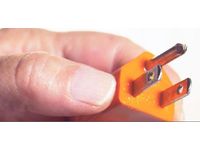IEEE Fails to Ratify Powerline-Networking Standard—Again
The IEEE P1901 Working Group once again failed to reach a consensus on a draft standard for broadband-over-power-line networking at its most recent meeting in Madrid, Spain. The joint proposal put forward by Panasonic and the HomePlug Powerline Alliance, however, remains the odds-on favorite to win the next round of voting, scheduled for November 4 through 6 in San Francisco.
In an interview after the vote, we asked HomePlug Powerline Association (HPA) president Rob Ranck why he thought the proposal failed to pass muster with the working group.
“Well, some people voted against the proposal for technical reasons,” Ranck said, “and others voted against it for non-technical reasons. If a proposal doesn’t pass after two votes, the group returns to the down-selection process. At that time, new proposals can be put forward and proposals that were eliminated earlier can be brought back.” When we asked Ranck if he thought some of the working-group members’ “non-technical” reasons for voting against the Panasonic-HPA proposal were political in nature, he replied “Well, you used that word, I didn’t.”
If those dissenting members were hoping that the previously rejected proposal put forth by the Universal Powerline Association (UPA) would win, they were likely disappointed. The UPA’s competing proposal is based largely on power-line networking technology developed by the Spanish company DS2; and the P1901 working group did re-examine it during the down-selection process, but ultimately voted once again to eliminate it from consideration.
Asked if he was confident that the Panasonic-HomePlug proposal would be ratified during the next vote, Ranck replied “We’ve been close twice now, but confident is one of those words I’m hesitant to use. I am optimistic, I will say that. If we can get the people who are voting against it for technical reasons to support it, we’ll be okay. I’m not sure we’ll ever convince those members who oppose it for non-technical reasons.”
There are three elements to the power-line networking standard, which the IEEE P1901 working group refers to as “clusters.” The Access cluster refers to power-line networking outside the home, where electrical utilities use the power lines to for meter reading and to monitor the health of the electrical grid. Internet service providers can also use the electrical grid to deliver broadband Internet access (typically in rural areas beyond the reach of more conventional services, such as cable TV service and DSL). The In-Home cluster refers to power-line networks inside the home. And the Coexistence cluster governs how similar technologies can operate within the same environment without interfering with each other.
IEEE rules require that any proposed standard win approval from 75 percent of the working group, which is a very high hurdle (one that explains why the IEEE 802.11n wireless networking standard remains stuck in Draft 2.0 mode). In the Madrid vote, 69 percent of the IEEE P1901 working group voted in favor of the Panasonic/HomePlug proposal for the In-home cluster and 48 percent voted in favor of that group’s Access cluster proposal.
Get Tom's Hardware's best news and in-depth reviews, straight to your inbox.
After those two proposals failed to win 75 percent majorities, however, 80 percent of voters abstained when it came time to ratify the Co-existence proposal put forth by the HomePlug Powerline Alliance and CEPCA (CEPCA is another consortium whose members include nearly all the Japanese consumer-electronics manufacturers, including Panasonic, Sony, and Hitachi).The abstentions were something of a forgone conclusion since there was no standard to coexist with.
